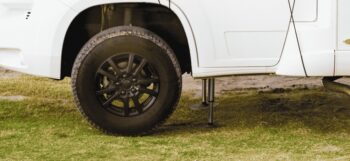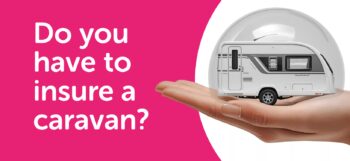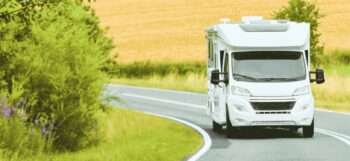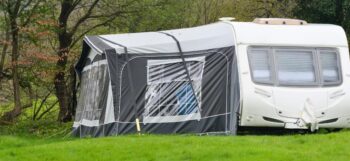Driving your motorhome for the first time may seem daunting, but it’s much easier than you think. If you can drive a car, you can drive a motorhome. With some basic awareness and the right driving techniques, you’ll be able to drive your motorhome safely to your chosen destination.
In this article, we cover some of the things you’ll need to consider when driving your motorhome and offer some additional tips for a stress-free driving experience.
Let’s explore what you’ll need to know.
Can I drive a motorhome on a normal driving license?
First things first. Before you start driving your motorhome, you must be sure you’re legally permitted to do so.
In the UK, being able to drive a motorhome is dependent on two things:
- When you passed your driving test
- The weight of the vehicle you intend to drive
Our article Are you licensed to drive a Motorhome? explains what you’ll need to know in greater detail.
Get to know your vehicle
The most apparent difference between driving a car and a motorhome is the size.
Your motorhome will be taller, wider, and heavier than the car you’re used to driving. And as well as making some roads inaccessible, the increase in size will also impact how you handle your new motorhome, while driving.
Familiarise yourself with its size and weight by taking it for a test drive in a quiet, local area. This will help you to get a feel for performance and handling. It can also help to reduce the risk of you having an accident and make you feel more confident for your first trip.

Know your width
Getting used to the width of your motorhome can take a bit of time, especially when navigating around obstacles like parked cars. The average motorhome is around 3ft wider than the average car, so if you often drive towards the centre of the road, you will need to bear this in mind to avoid crossing over to the other side. When driving in built up and residential areas or narrow country lanes, get into the habit of driving closer to the pavement than you normally would do. Use your wing mirrors, or the help of a passenger, to ensure you do not clip the pavement or mount the kerb.
Know your height
Remembering the height of your motorhome can help you to avoid issues when driving towards low bridges and height barriers. Don’t leave it to guesswork. Write the height and width of your motorhome on a label and attach it to the sun visor, for quick reference. Pay attention to overhanging branches and vegetation at the roadside, which may force you to take avoiding action. If it’s a windy day, a large vehicle such as a high-sided motorhome will be more affected by crosswinds than smaller cars.
Know the speed limits for motorhomes
In general, motorhomes need to comply with slower speed limits, especially if the maximum unladen weight is over 3.05 tonnes, or you’re towing your motorhome. Unladen weight is the weight of the vehicle when it’s not carrying passengers, camping equipment or other items. It includes the body and all parts normally used with the vehicle but excludes fuel or batteries in an electric vehicle.
The infographic below shows you the speed limits you need to adhere to on UK roads when driving your motorhome. Further information can be found on the Gov.UK website. If you drive your motorhome in Europe, European motorhome speed limits may vary.

Watch your distance
Driving at a slower speed is advisable, particularly if you are not used to driving your motorhome. Heavy vehicles, such as motorhomes, take longer to slow down. So, one of the most important safety considerations when driving your motorhome is your stopping distance, especially if you’re used to driving a smaller vehicle.
The Highway Code states: “Large vehicles and motorcycles need a greater distance to stop. If driving a large vehicle in a tunnel, you should allow a four-second gap between you and the vehicle in front.”
The condition of your tyres can also have an impact on your stopping distance. According to the Royal Society for the Prevention of Accidents, a 1.6mm tyre tread, which is the lowest legal limit, increases stopping distances by up to 45%[i]. Low tyre pressure can also increase stopping distances. So, it’s essential to get your tyres checked regularly to make sure they’re roadworthy and will slow you down, without fail.

With the above considerations in mind, we have listed a few things that will help you while you’re out on the road.


Gadgets
There are a plethora of gadgets on the market designed to take the hassle out of driving your motorhome.
These include rear cameras for reversing, parking sensors and add-on mirrors, all of which can help you while performing driving manoeuvres. While gadgets are handy, it’s important not to solely rely upon them. If a gap looks too small, it probably is. Using common sense is the best way to avoid accidents and prangs.
Know where you’re heading
From finding the best roads to travel on, to checking the rules and regulations at a campsite you’re staying on, a little pre-travel research goes a long way to enhancing the quality of your trip. Sat nav’s are your friend when you’re on the road and you can even use Google 360 street view, so you know what to expect when you reach your destination.
Get yourself covered
With motorhomes being much larger than standard cars, the risk of accidental damage is also much greater. Thankfully, we’ve been supporting motorhome owners just like you for over 40 years, so we know a thing or two about your insurance requirements. We work with leading UK insurers such as AXA, LV and Ageas, to bring you feature packed motorhome insurance and optional extras, such as RAC breakdown insurance, giving you peace of mind that you are in safe hands.
For further details on the motorhome policies we have on offer, visit https://www.lifesure.co.uk/personal-insurance/motorhome-insurance or call us on 01480 402 460.
Disclaimer: The sole purpose of this article is to provide guidance on the topic covered. This article is not intended to give legal advice, it should not be relied upon. It should not be regarded as a comprehensive statement of the law and/or market practice in this area. We cannot guarantee the completeness or accuracy of the information contained in the external links, which were live at the date of publication.











